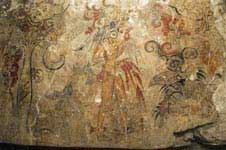Archaeologist William Saturno from the United States announced yesterday that he was astonished to discover a Maya mural that had not been seen for nearly two millennia.
 The mural was found in the San Bartolo region of Guatemala, covering the entire west wall of a room connected to a pyramid, Saturno revealed.
The mural was found in the San Bartolo region of Guatemala, covering the entire west wall of a room connected to a pyramid, Saturno revealed.
With vibrant colors, the mural depicts the creation history of the Maya. This artwork was painted around 100 BC but was later covered when the room was buried.
Saturno, who currently works at the University of New Hampshire, first reported on this area in 2002 when he stopped to rest in a cave in a dense forest, which was later discovered to be part of the ancient room.
Since then, the west and north walls have been excavated. The remaining walls were collapsed to level the room. The mural on the west wall is the highlight of the room, depicting four deities, which are different representations of the corn god’s son.
Saturno explained: The first deity stands on the water holding a fish – representing the underwater world. The second deity stands on the ground offering a deer – representing the earth. The third deity flies in the air holding a turkey – representing the sky. The final deity stands in a flower meadow – the food of the gods – representing paradise.
Another section depicts the corn god crowning himself on a wooden scaffold, and the final section illustrates the historical coronation of a Maya king. Some of the inscriptions are decipherable, but most are too old to translate.
Nearby, archaeologists also discovered the oldest known royal Maya tomb, dating back to 150 BC. Excavated beneath a small pyramid, the team found a tomb containing pottery and the bones of a man, with a jade plaque placed on his chest – a symbol of Maya royalty.

















































